3DPrint.com | The Voice of 3D Printing / Additive Manufacturing |
- Steel Giant Takes Home Large-Scale Metal 3D Printer from Eplus3D
- Bioprinted Wagyu Beef to Hit Automated Production by 2025
- A Trip to Nano Dimension HQ: Electronics 3D Printing Live and In-Person
- Swarm 3D Printing Heralds Future of Lights-Out Manufacturing
- The BioElectroCathode Project: The Future of Biofuels, Thanks to an Industrial 3D Printer
| Steel Giant Takes Home Large-Scale Metal 3D Printer from Eplus3D Posted: 19 Apr 2022 06:30 AM PDT Rapidly expanding metal powder bed fusion (PBF) manufacturer Eplus3D has found an important client in JINGYE Additive Manufacturing, a subsidiary of Hebei JINGYE Group. Best known for being the owners of British Steel, the $4 billion conglomerate is one of the world’s largest steel companies. JINGYE has acquired an EP-M650, a quad laser metal 3D printer with a sizable build volume of 655 x 655 x 800 mm (2.15′ x 2.15′ x 2.63′).
Eplus3D is a newly emerging maker of inexpensive metal PBF 3D printers that are more than a tad reminiscent of PBF systems made by certain other firms. Together with Farsoon, they exemplify a bold set of Chinese players who aim to conquer the additive manufacturing (AM) OEM market for metals. We’ve mentioned before that Eplus does not only have low-cost machines, but rather large ones, too. This includes the EP-M450H, which has a build volume of 455 by 455 by 1100 mm, as well as the EP-M650.
Now a few things here that make this very interesting indeed. First off, this could mean that Chinese firms are able to produce cutting-edge systems in the very highest regions of our current market. Everyone expects Chinese OEMs to snip at the heels of established competitors on the accessible end of the product portfolio. However, this may mean that Chinese firms will try to sell their much more expensive wares internationally, as well. JINGYE´s involvement also points to serious levels of Chinese commercial capital being available to develop 3D printing at an industrial scale. What’s more, with both firms touting this as a part of the “development of high-end manufacturing and intelligent manufacturing industry,” much more local, regional, or national funding could be in the offing. It is a priority for China to develop high-end manufacturing nationally. In our, “China’s Belt and 3D Printed Road” series, we’ve explored China’s accelerated national development of additive manufacturing (AM). This is a key national priority. We’ve looked at how the country is using 3D printing technology to advance complex manufacturing skills, as well as how it will use AM to extend its technological capabilities. We’ve also pointed out that the global 3D printing market is split in two, with Chinese firms turning almost exclusively to Chinese OEMs for 3D printers. 3D printing is also an integral part to China’s self-sustainment strategy and to its attempts to make aero engines and craft. What we are seeing here is validation of that thesis that the 3D printing market is actually bifurcated. China will serve as a home base to incubate Chinese 3D printing technology and give companies revenue for expansion. If you are a legacy OEM outside of China and this doesn’t scare you, it probably should. The post Steel Giant Takes Home Large-Scale Metal 3D Printer from Eplus3D appeared first on 3DPrint.com | The Voice of 3D Printing / Additive Manufacturing. |
| Bioprinted Wagyu Beef to Hit Automated Production by 2025 Posted: 19 Apr 2022 06:00 AM PDT Soaring demand for meat alternatives has prompted Japan-based Osaka University to team up with Kyoto biotechnology research corporation Shimadzu and Tokyo consulting firm Sigmaxyz to create a new food tech ecosystem, which includes the development of cultured meat via its bioprinting technology. Furthermore, the three parties have signed a collaboration deal to use bioprinting to solve environmental and food issues and improve healthcare, drug discovery, and medicine. The collaboration's core foundation is a bioprinting technology that creates muscle tissue structures developed by Michiya Matsusaki, an Associate Professor at Osaka University's Graduate School of Engineering. At his lab, Matsusaki and his group of researchers have been exploring how to produce artificial steak-like meat, especially the highly marbled Wagyu steak.  Osaka University researchers created cultured steak with bioprinting. Osaka University/Nature Communications. Many of the cultured meats reported so far have a minced structure consisting only of muscle cells, making it challenging to reproduce complex structures. However, Matsusaki and his co-researchers developed a bioprinting process that uses 3D printing to produce the different fibrous tissues (muscle, fat, and blood vessels) and then integrates them into a bundle. By investigating how to culture stem cells taken from Wagyu cattle, Matsusaki's team has been assembling them using a 3D printer to make a meat alternative of muscle, fat, and blood vessels that mimic the arrangement of a conventional steak. In 2021, they succeeded in creating steak-like meat measuring five millimeters in diameter and ten millimeters long and consisting of muscles, fat tissue, and blood vessels. When sliced perpendicularly, the beef had a marbling structure resembling Wagyu beef. 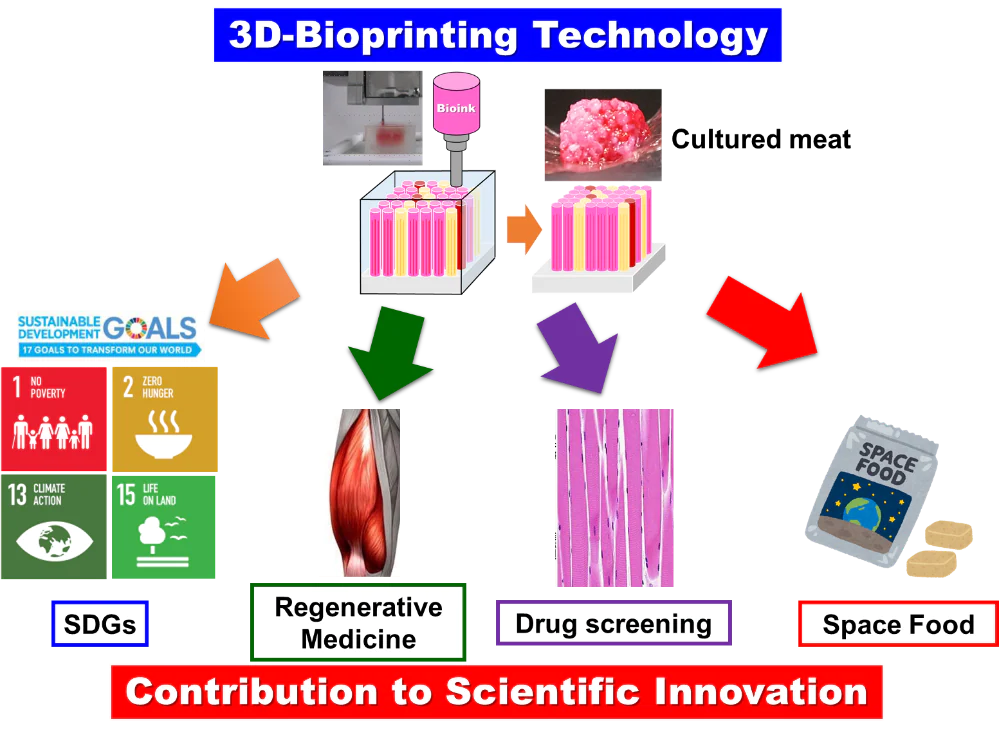 Scientific and technological development based on 3D printing technology. Image courtesy of Shimadzu. Researchers can create “cultured meat with a controlled arrangement of muscle, fat, and blood vessels through this technology.” In addition, this bioprinting methodology has made it possible to reproduce the uniquely beautiful marble design called Sashi, characteristic of Wagyu beef, and "delicately adjusting the fat and muscle components," described Shimadzu in a recent statement. An expert in biomaterial and biomedical engineering, Matsusaki has shown engineered marbled Wagyu meat by using a newly developed bioprinting technique. The work has attracted a great deal of attention both domestically and internationally. However, Matsusaki anticipates that “you can’t eat it yet, so you're going to have to wait. But everyone seems to be very interested in it.” Indeed, that interest led to this collaboration. Ultimately, Osaka University and Shimadzu will jointly develop bioprinting equipment to automate cultured meat production, hoping to present it in time for the 2025 World Expo in Osaka, held between April 13 and October 13 of that year. According to Sankei News, the team will initially target high-quality meat that exceeds 100 grams and ¥10,000 (roughly $80). Thanks to bioprinting technology, we have seen companies devising new meat alternatives in the last few years. From Spanish startup Novameat's proprietary bioprinting technique to MeaTech 3D, a company dedicated to creating cultured meat, the broad spectrum of possibilities with the technology is taking the "fake meat" industry by force. However, at its core, bioprinters were developed to create living tissues from bioinks of cells, nutrients, and other biocompatible substances. Therefore, in promoting the creation of cultured meat, the Japanese partners will also develop healthcare models in regenerative medicine and drug discovery, such as internal organs using human cells. 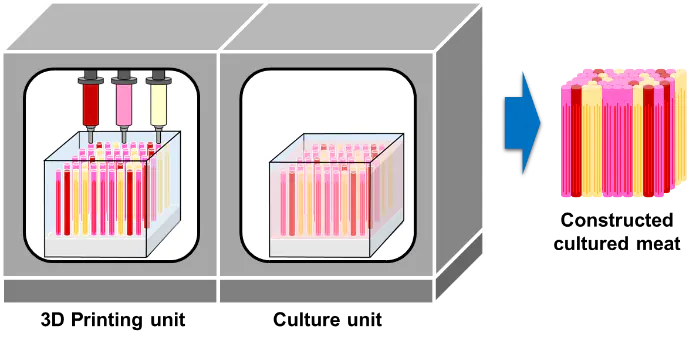 Illustration of an automated tailor-made cultured meat production device by 3D bioprinting. Image courtesy of Shimadzu. Each of the three collaborators will play a crucial role in the partnership. Osaka University will continue its efforts to develop tissue engineering technologies, including the 3D bioprinting technique developed by Matsusaki. So far, his unique approach has been ideal for building muscle, fat, and blood vessel fibers, but reproducing more complex tissue and organ structures has been a challenge and will be one of the targets in the future. Osaka University has indicated it will focus on developing the essential technologies to realize new “reconstruction of complex tissue and organ structures” and “long-term culture of organ models by the circulation of nutrients and oxygen through blood vessels.” Shimadzu will leverage its know-how to automate cultured meat production and analyze the cultured meat’s taste, texture, flavor, chewiness, and nutritional content. With over 40 years of history, this company has a lot of expertise to draw from. Notably, in recent years, it has focused on developing equipment and technology to automate and streamline the cell culture process through artificial intelligence and robot technology and engaged in research with the National Agriculture and Food Research Organization to analyze the functional components of agricultural products. Further, Sigmaxyz will serve as the program management office for the social implementation of 3D bioprinting technology. The post Bioprinted Wagyu Beef to Hit Automated Production by 2025 appeared first on 3DPrint.com | The Voice of 3D Printing / Additive Manufacturing. |
| A Trip to Nano Dimension HQ: Electronics 3D Printing Live and In-Person Posted: 19 Apr 2022 05:30 AM PDT Earlier this month, I traveled to Israel for a 3D printing event and several site visits. The final company I had the opportunity to see while in the Tel Aviv area was printed circuit board (PCB) leader Nano Dimension. When I first began writing for 3DPrint.com in 2016, Nano Dimension was a frequent topic. It announced customer after customer for its newly released DragonFly 2020, touted as the world’s first desktop electronics 3D printer. The company has been going strong ever since. It released its industrial DragonFly 2020 Pro 3D printer in 2017. It opened its first 3D printed electronics service bureau a year later. And it continued to announce advantageous partnerships. Most recently, Nano Dimension unveiled its DragonFly IV this fall, and I was excited to see it for myself at the company’s Israeli headquarters in Ness Ziona. 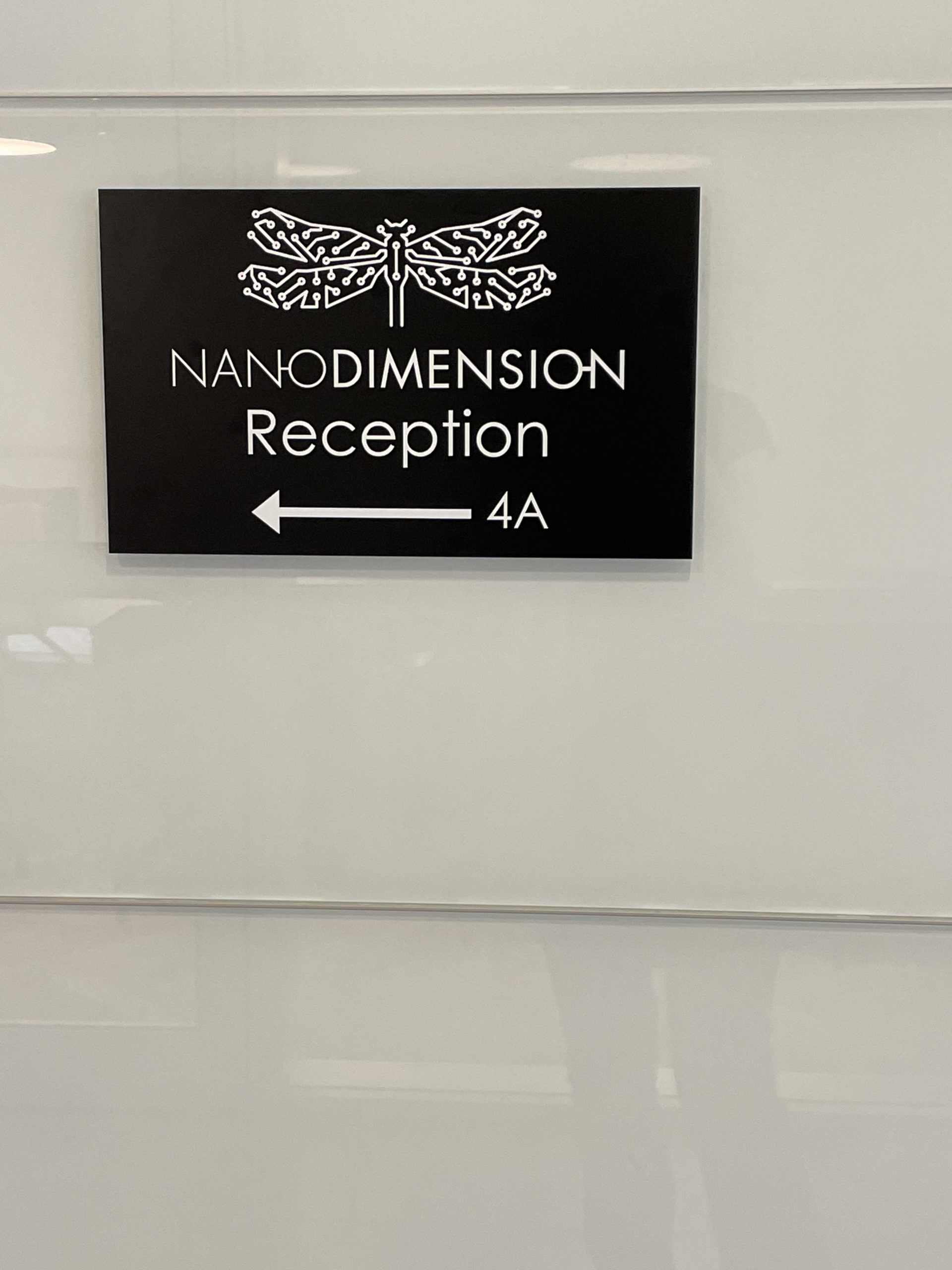 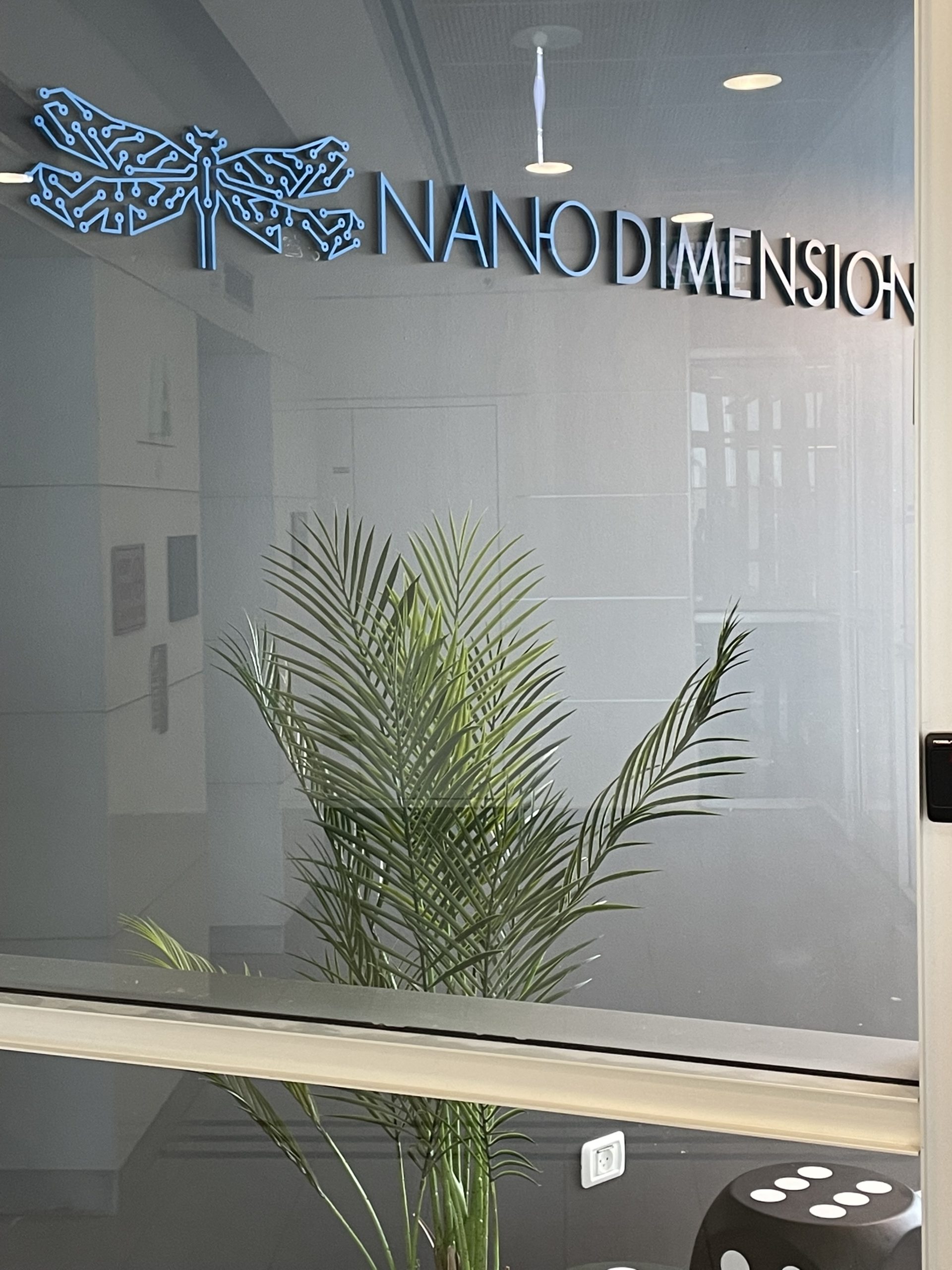 I was met in the reception area by Julien Lederman, Director of Corporate Development for Nano Dimension, who then took me on a quick tour of the space. We started with the area that houses Nano Dimension’s Additively Manufactured Electronics (AME) systems. These, as Lederman explained, have “effectively two materials in the same printer at the same time.” These include both Nano Dimensions’ proprietary conductive and nonconductive materials, developed in a materials area located on the first floor of the building. The second floor is where the company’s Fabrica Group (formerly Nanofabrica) 3D printers are. Last year, Nano Dimension acquired and rebranded the microscale AM company, which specializes in precise, tiny 3D prints with features down to 1 micron in size. This was the company’s first acquisition in the AM sector, and as Lederman explained, there are plans for Nano Dimension to acquire more AM companies and “become a dominant player.” Though it was the first in the AM space, Nanofabrica was certainly not the company’s first ever acquisition. In fact, the same week that Nano Dimension purchased Nanofabrica, it also acquired DeepCube, a real-time, deep machine learning, AI company. By integrating DeepCube’s software platform into its solutions, and those of its other acquired companies, Nano Dimension can close the loop in smart industrial solutions and “execute machine learning on the fly.”
I asked Lederman how micro 3D printing, and other acquisitions, fit into Nano Dimension’s larger tech strategy. He filled me in, starting with electronics company Essemtec, which develops technology for pick-and-place technology. Nano Dimension sells Essemtec’s electronic manufacturing services (EMS) to its assembly customers. Additionally, as Nano Dimension fabricates its PCBs layer by layer, Essemtec’s solutions make it possible to embed components inside and on top of the PCBs. Nano Dimension also acquired UK-based company GIS (Global Inkjet Systems), which is focused on inkjet technology—the “primary tech in our AME solutions.” GIS has hundreds of global customers in the 3D printing and graphic arts sectors, and sells ink delivery systems, controller electronics for inkjet printheads, and the software that “orchestrates all these components together.” This acquired company has significant revenue, which makes it an ideal acquisition. However, its complementary technology was the real draw here, as Nano Dimension can maximize its own inkjet process used in its AME solutions. Hanan Gino, CPO and Head of Strategic M&A at Nano Dimension, joined us then, and he and Lederman explained to me that the company’s portfolio offers a proof of concept for academia in regards to AME. According to the executive, the firm’s next-generation systems will be focused on prototyping first, with functional PCB manufacturing coming later. The end goal is to sell the solution to manufacturers producing PCBs. In regards to its strategic acquisitions, Nano Dimension looks for technology that complements its own AME solution, in addition to equipment vendors in the same domain, “which means horizontal integration.”
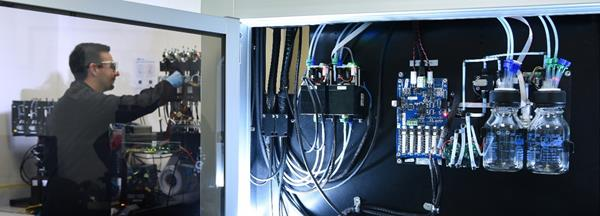 Global Inkjet Systems showing Inkjet System Components in a laboratory environment. Image courtesy of Nano Dimesnion. Gino explained that Nano Dimension has a “unique operation,” and that it’s growing fast. When he joined the team a year ago, there were 80 employees, but after four acquisitions, they’re close to 500.
Nano Dimension also invests a lot in different feedstocks for different applications, because the company believes each application will require a unique material. Gino said that Nano Dimension works with 20 external material companies to develop additional feedstocks, and that the company also develops two main families of inks—conductive and electric—in-house. I asked how many PCBs the DragonFly can make in a single print process. Gino said it depended on how many materials were needed, as well as the complexity of the product and the number of layers required. But he was able to give me a ballpark figure and said it can take “tens of hours to fabricate this kind of product.”
Gino explained that for one of their customers, which he wasn’t allowed to name but assured me had plenty of available revenue, Nano Dimension replaced its entire PCB lines—which used to consist of 70-100 stages—with a single solution. This was helped by the fact that the company has several R&D centers, with the main one in Israel, another in Boston, and one in Munich. This helps shorten the time to market.
He said that Nano Dimension also has enough revenue to be disruptive, and has recruited people from some other big-name companies, like Amazon, 3D Systems, and PCB manufacturing company TTM.
Speaking of TTM, it’s the leading PCB manufacturer in the western world, according to Gino. It is also one of Nano Dimension’s partners, having purchased three of its DragonFly systems. He also mentioned Jetted Additively Manufactured Electronics Sources (JAMES). JAMES is a joint venture with Hensoldt AG, a market leader in civilian and military sensor solutions and defense and security electronics. The goal behind this is to develop a crowdsourcing platform in order to get more people involved in 3D design. Nano Dimension also offers the AME Academy, which is a platform that offers different types of webinars that champion new types of electronics design. Before I left, Gino relayed some crucial specifics of Nano Dimension’s technology, first noting that strength and weight ratios, and internal architectures, are talked about a lot with AME.
He explained that you are “bound by right angles of connections in the Z dimension and by physical limitations of a PCB” with traditional printed circuit boards, but that you don’t have this limitation with AME.
Gino told me that the biggest pain points in traditional PCB manufacturing are holes drilling, holes plating, and the registration between layers. These issues can be overcome with AME because Nano Dimension doesn’t drill holes.
Gino said with Nano Dimension’s solution, “the pads on a PCB can be connected from any point to another directly,” instead of only through the vias, which are holes drilled to connect conductors on different layers.
To see Nano Dimension’s PCB technology for yourself, come visit the company at Rapid.Tech 3D in Erfurt, Germany, and at RAPID + TCT in Detroit, Michigan, May 17-19. The post A Trip to Nano Dimension HQ: Electronics 3D Printing Live and In-Person appeared first on 3DPrint.com | The Voice of 3D Printing / Additive Manufacturing. |
| Swarm 3D Printing Heralds Future of Lights-Out Manufacturing Posted: 19 Apr 2022 05:00 AM PDT A number of firms have advocated for—and even carried out experiments in—collaborative 3D printing robots. However, few have brought a suite of 3D printing robots to market. Arkansas-based AMBOTS is one of the few exceptions. Established in 2015, the firm is dedicated to swarm 3D printing, with AMBOTS as an acronym for "Autonomous Mobile roBOTS and Advanced Manufacturing roBOTS." The company is led by Dr. Wenchao Zhou, founder and director of the AM3 Lab at the University of Arkansas. So far, AMBOTS has developed a very unique technology, in which multiple thermoplastic extrusion robots work together to 3D print the same object. This isn't just a dual extruder slapped onto a RepRap. These are multiple separate extruders that can be picked up and moved by mobile robots around a miniature factory floor to print the object. More than that, the robots can perform pick-and-place assembly to create fully functional objects.
The company describes its methodology in this way:
To coordinate all of this activity, the company has created software that can take a 3D model, split it into smaller tasks and assign them to the various bots. They are then scheduled to finish their objectives sequentially and in parallel. The robots are powered by an electrified floor, enabling wireless energy generation. Other features in development include robots that perform tape-laying, screw driving, adhesive printing, and inkjetting.
AMBOTS' technology is remarkable, to say the least. As we have seen by companies like Ocado, warehouse robots can now perform unprecedented sorting and retrieval tasks at blinding speeds. The grocery and robotics firm also 3D prints some 300 parts for its warehouse fleet using HP's Multi Jet Fusion technology. Divergent 3D has also developed an industrial robotic production platform, in which a collection of robotic arms collaborates to assemble 3D printed metal parts into a complete vehicle. Divergent CEO Kevin Czinger says that this fixtureless system can theoretically go from building a hypercar to building a drone with zero hardware modifications necessary. It's not hard to imagine that AMBOTS could scale its technology to create machines with a similar size to those used by Ocado or Divergent. Because AMBOTS also features 3D printed parts on its systems, we might envision them even duplicating themselves, finally fulfilling the RepRap dream of self-replicating 3D printers. Combined with Czinger's technology and/or Ocado's, the "lights-out factory" could finally be achieved. Before we get to that point, of course, there are countless questions to ask. Is a self-replicating, lights-out factory something any rational, empathetic human actually wants? Not only are there the considerations about displacing workers and the possibility of an all-powerful artificial intelligence. We also have to think of the ecological consequences of an endless factory. Global society already operates on a basis of 24/7 production-consumption, such that countries like China manufacture nearly everything for nations like the U.S. to the detriment of our planetary ecosystem and its interdependent inhabitants. And it does so in a nearly automated fashion, except that the inputs are human and ideological rather than robotic and code based. Even under the existing system, it has become almost impossible for the public to intervene in any meaningful way. The Paris Agreement is a case in point The only difference between the existing system and a lights-out factory would be that it could potentially produce more stuff more quickly. This would, in turn, result in destroying the planet at an even faster pace, perhaps with even less opportunity for human intervention. The post Swarm 3D Printing Heralds Future of Lights-Out Manufacturing appeared first on 3DPrint.com | The Voice of 3D Printing / Additive Manufacturing. |
| The BioElectroCathode Project: The Future of Biofuels, Thanks to an Industrial 3D Printer Posted: 19 Apr 2022 04:30 AM PDT BioElectroCathode is an innovative project which aims to develop bioelectrosynthesis processes that can be used to convert carbon dioxide (CO2) into methane (CH4) or ethanol. The two main pillars of the project are the application of 3D printing technology for the production of electrochemical bioreactors and the development of methods to produce the cathodes necessary for the bioelectrosynthesis process. The entire process enables the conversion of CO2 into a biogas-like gas that can be used as fuel. Can 3D printing technology from Omni3D help produce the fuels of the future? An international, Poland-Cyprus team of scientists in collaboration with Omni3D is working on a technology that in the future may help solve three major problems of today’s energy systems, related to energy storage, grid stability and CO2 emissions. The BioElectroCathode project aims to innovate the biocatalysis of bioelectrosynthesis processes by:
What is the BioElectroCathode project about?In the 3D printed bioreactor, optimal conditions are created for the growth of bacteria, which, stimulated by a small electrical charge flowing through the cathode, convert CO2 into methane or into ethanol. The 3D print was prepared to provide the best possible fluid flow for the bioelectrosynthesis process with simultaneous separation of the resulting gases: 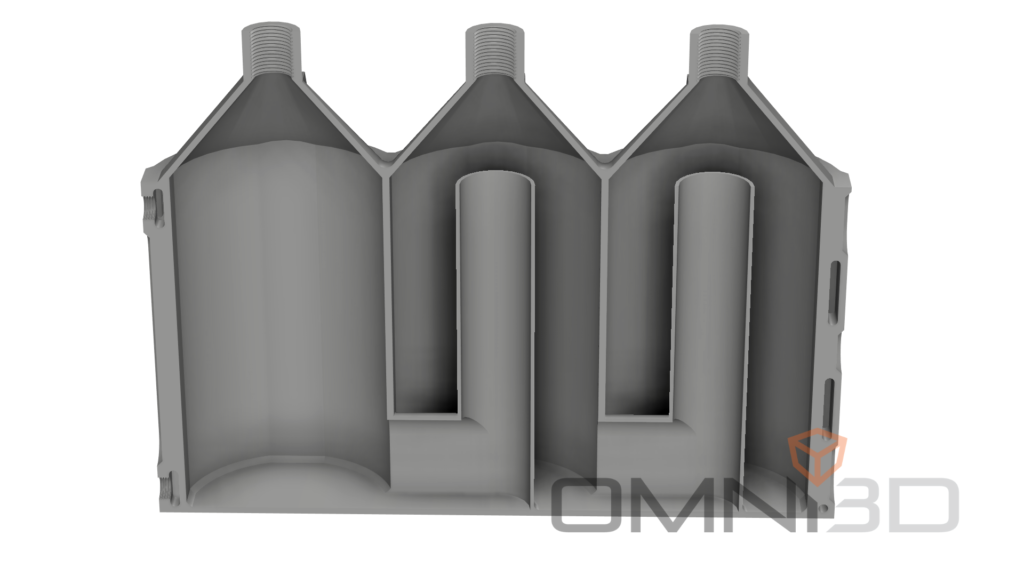 Cross-sectional view of 3D printed MEBR (3D-Microbial Electrosynthesis Baffle Reactor) The energy carrier produced in this way can be stored, distributed and used, for example, as fuel in gaseous fuel vehicles or in industrial production processes. The principle of the microbial electrosynthesis system is shown in the diagram below:  Schematic of the microbial electrosynthesis system in the BioElectroCathode project. [S. Bajracharya, Microbial electrosynthesis of biochemicals: innovations on biocatalysts, electrodes and ion-exchange for CO2 supply, chemicals production and separation, dissertation 2016.] What techniques were used to print the bioreactors?One of the biggest challenges during the project was preparing a fully tight 3D print to meet the requirements of the BioElectroCathode project. The goal was also to use tested and readily available thermoplastic materials, which in the future will serve for mass, energy-efficient and stable production of bioreactors by incremental technology. After many tests, ABS and CF-PA filaments were used for the models, and the printouts are created on a Factory 2.0 NET industrial 3D printer. The shape of the reactor evolved during the project to fully optimize the fluid flow inside the reactor:
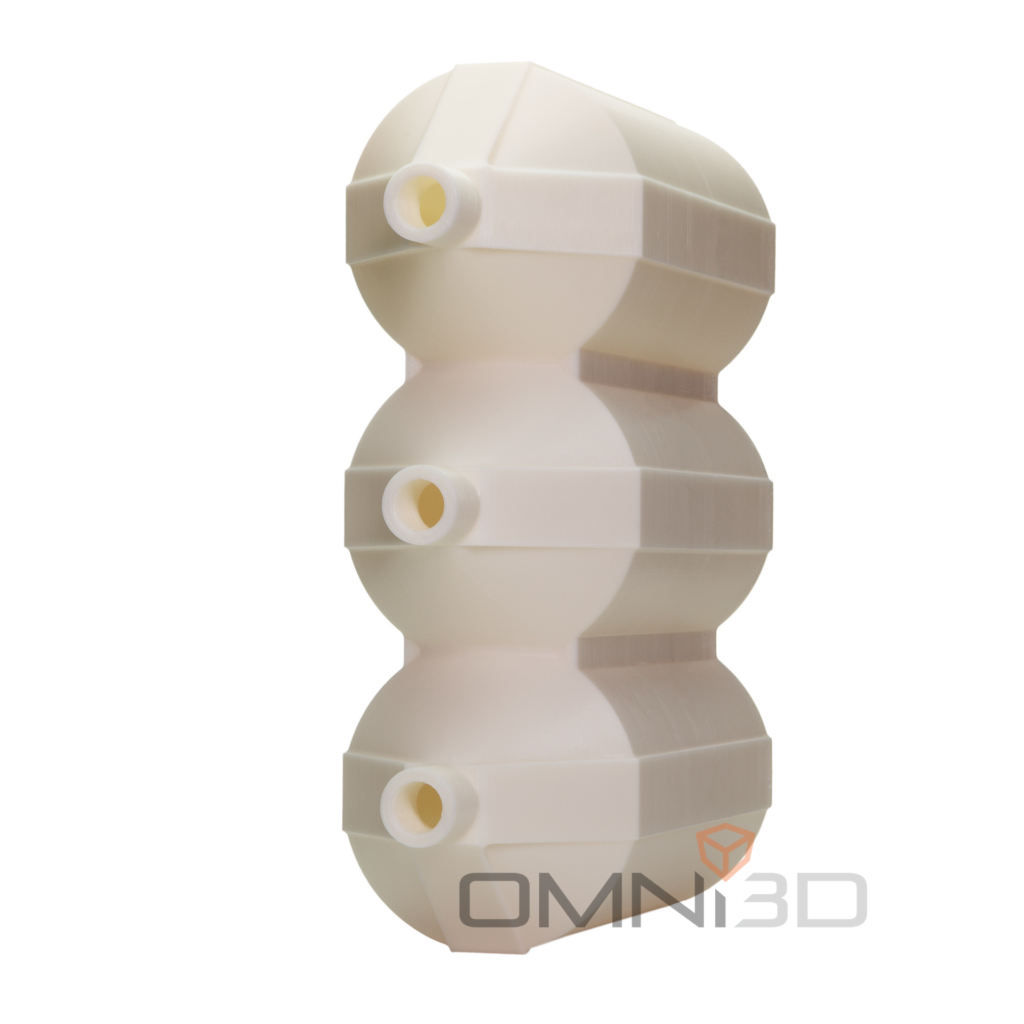 3D printing: 5 liter MEBR reactor (3D-Microbial Electrosynthesis Baffle Reactor) Factory 2.0 NET 3D printer equipped with Omni3D Web Control system allows for remote viewing of the 3D printout via camera and thanks to Omni3D AirCirculation function provides temperature control of the printout on its entire surface. Thanks to these features, work on the BioElectroCathode project was not only much easier, but also more efficient. “The bioelectrocathode science project has enabled Omni3D to identify a new application that is still unknown under standard industrial conditions. On the one hand, we have expanded our knowledge in the area of joining different polymer materials, tested the effects of pressure and temperature on the degree of bonding of model layers. On the other hand, we were able to provide a solution that I hope will contribute in the future to the improvement of living conditions on Earth.” – comments Pawel Robak, CEO of Omni3D Bioreactors are designed in such a way that their printing takes place without the use of supports. Thanks to this, as well as using a higher printing layer of 0.3 mm, the production time of bioreactor is significantly shortened. 3D printing allowed for multiple changes and improvements to the design. By changing the design parameters of individual reactor elements such as shape or thickness and degree of filling, the structure of the printed device can be easily manipulated and, consequently, the bioreactor’s operation can be improved. You can read more about the technology and the project on: www.omni3d.com
The BioElectroCathode project is carried out in the following partnership:
The post The BioElectroCathode Project: The Future of Biofuels, Thanks to an Industrial 3D Printer appeared first on 3DPrint.com | The Voice of 3D Printing / Additive Manufacturing. |
| You are subscribed to email updates from 3DPrint.com | The Voice of 3D Printing / Additive Manufacturing. To stop receiving these emails, you may unsubscribe now. | Email delivery powered by Google |
| Google, 1600 Amphitheatre Parkway, Mountain View, CA 94043, United States | |
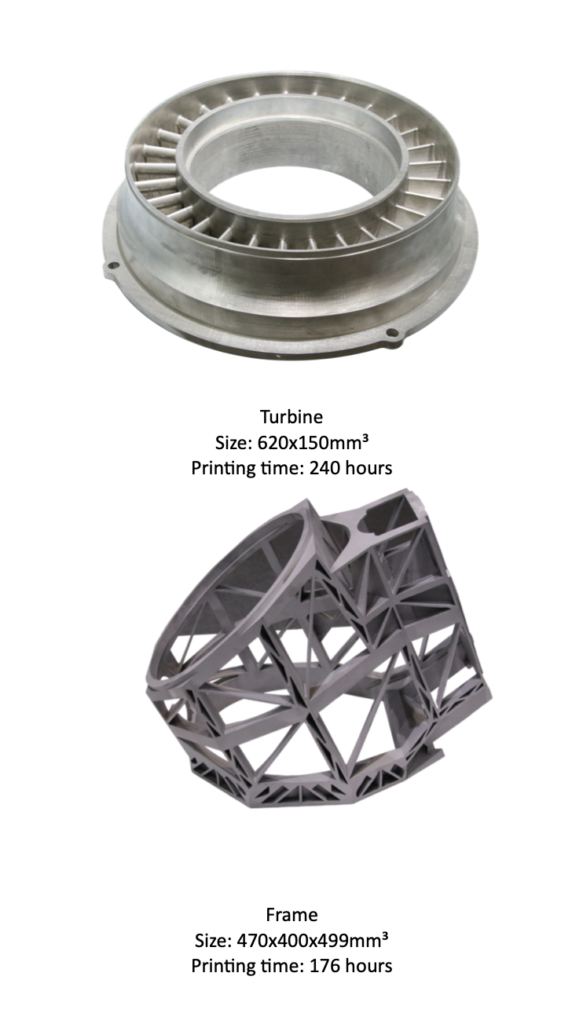
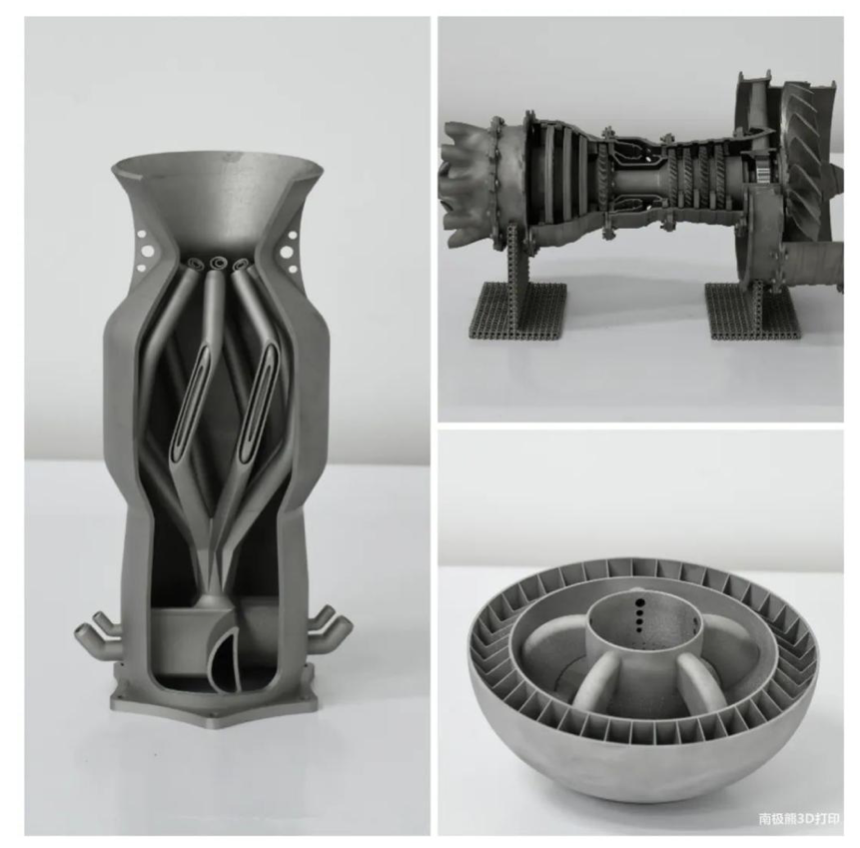
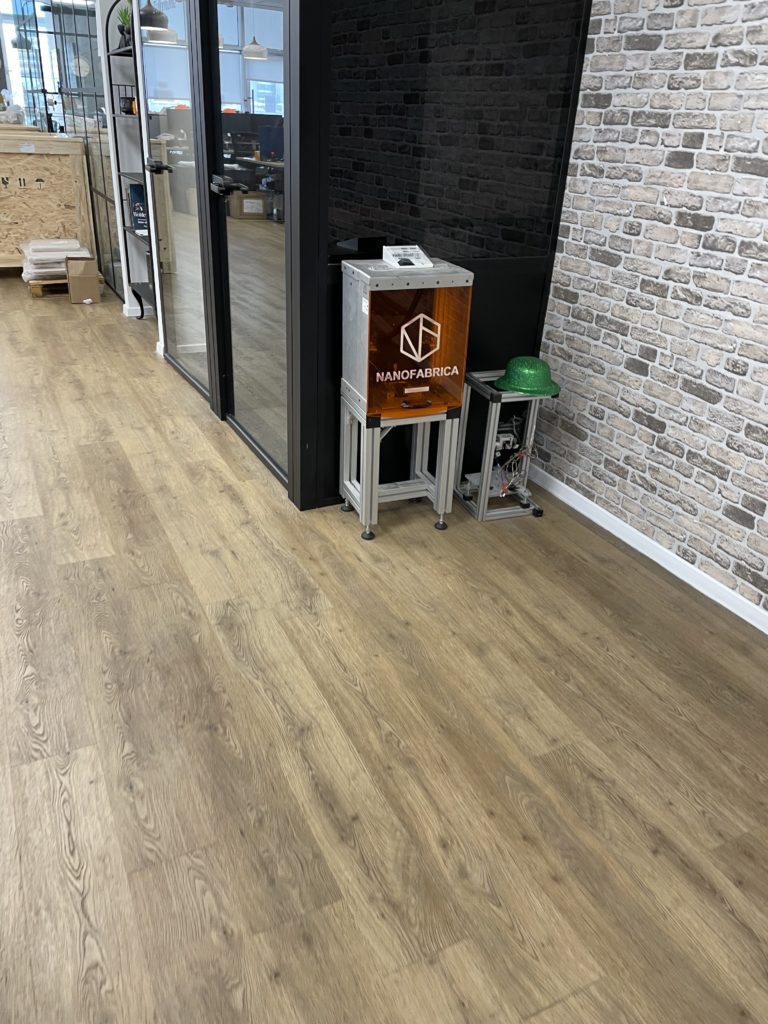
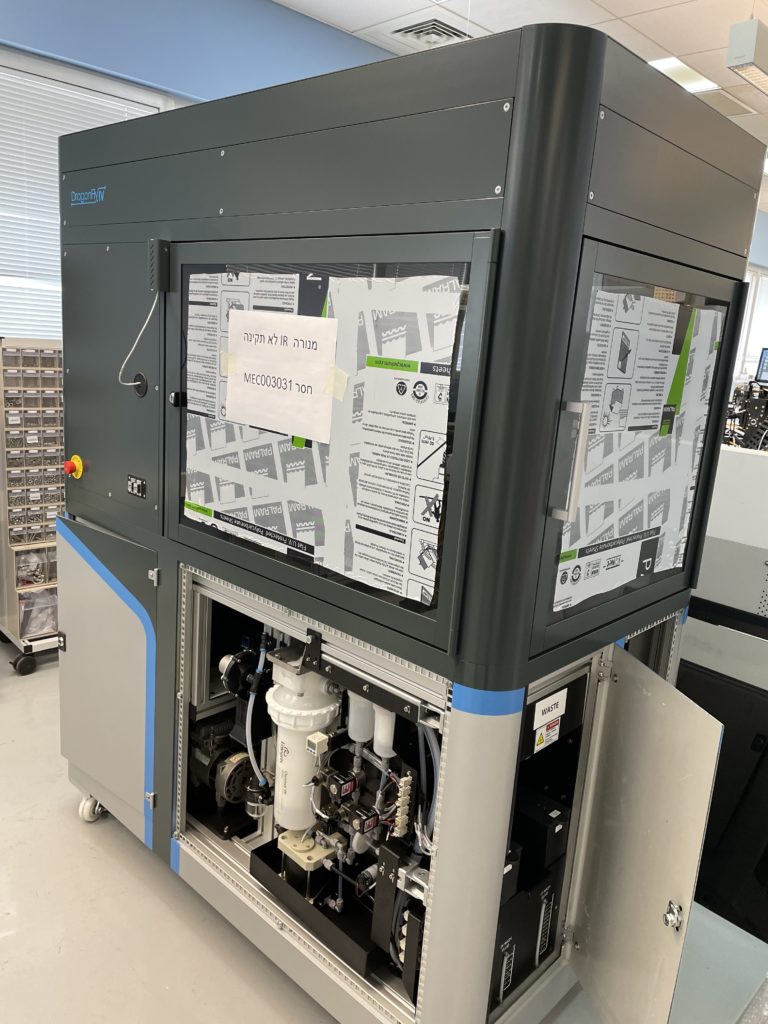
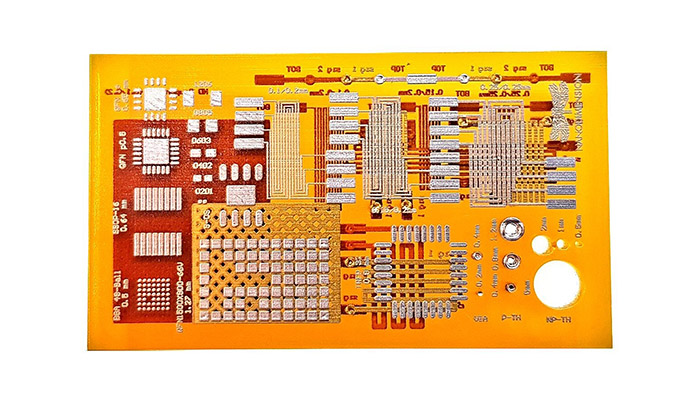
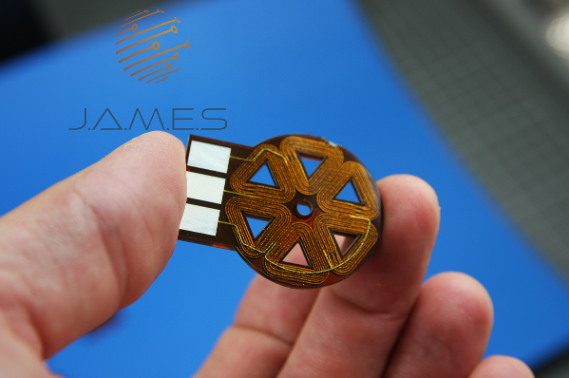
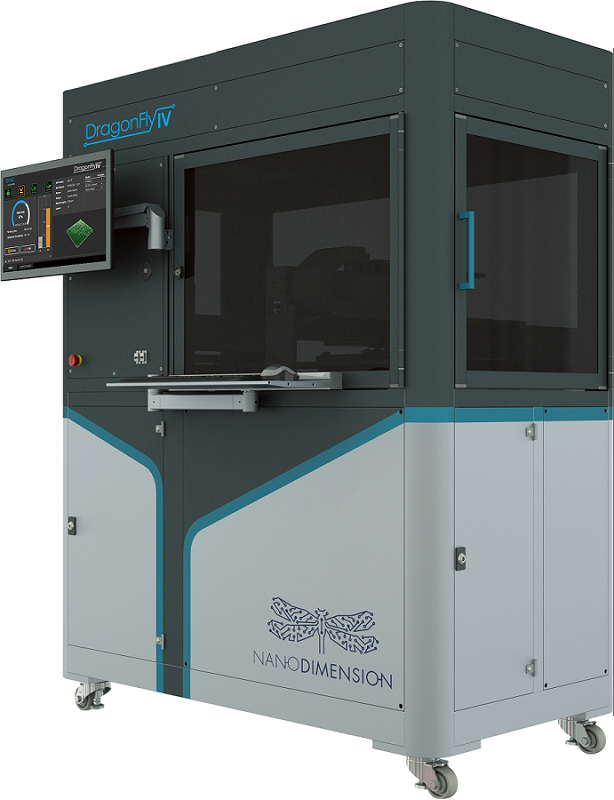
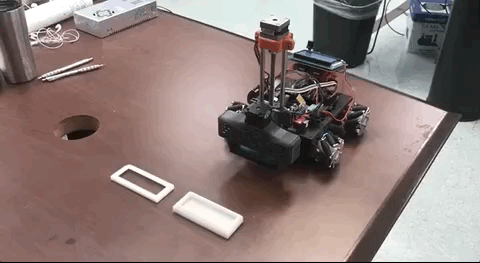
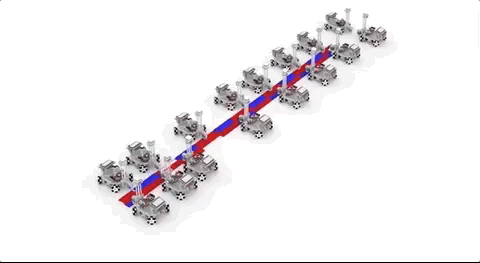
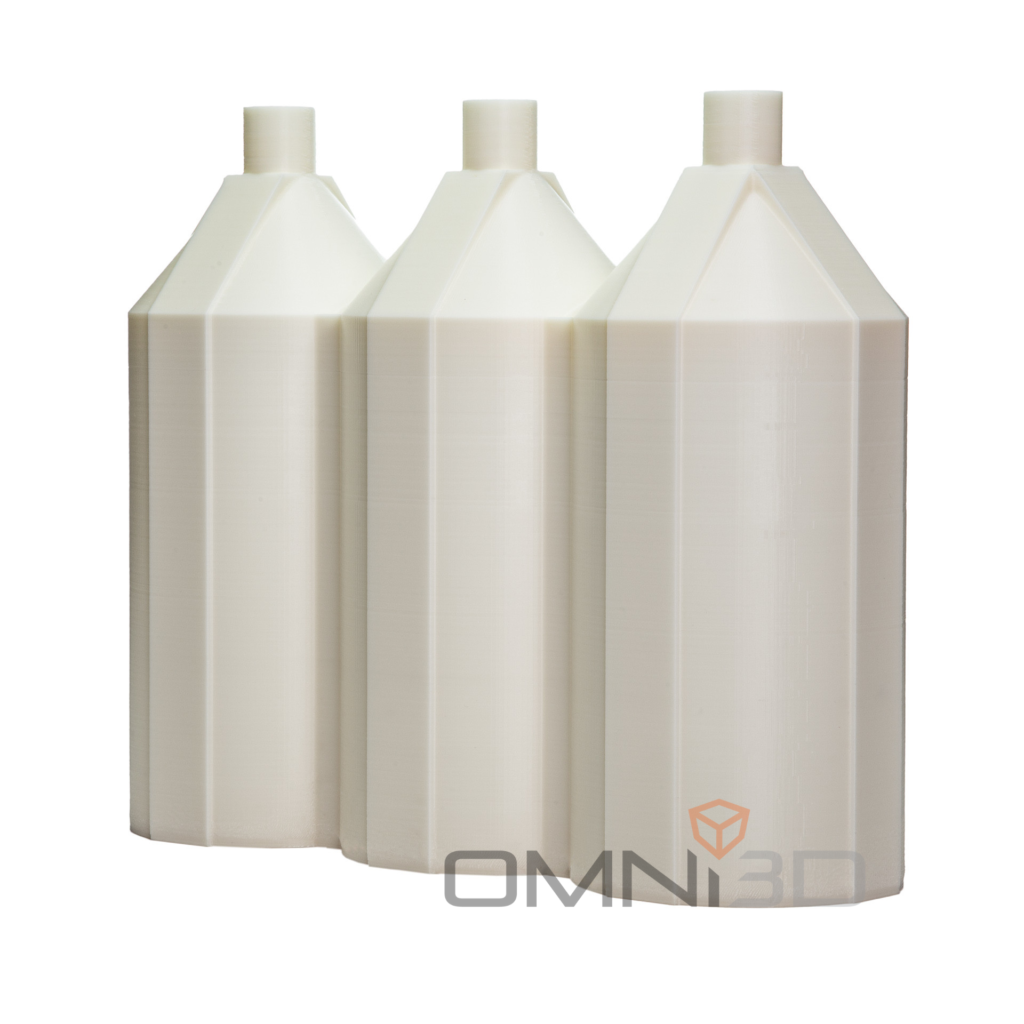


0 comments:
Post a Comment